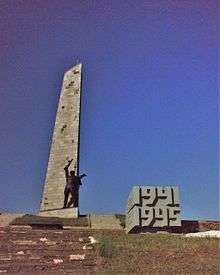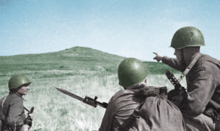Savur-Mohyla
Savur-Mohyla (Ukrainian: Савур-могила), sometimes transcribed as Saur-Mogila (Russian: Саур-Могила), is a strategic height in the Donets ridge near the city of Snizhne, located about 5 km (3.1 mi) from the border between Ukraine and Russia's Rostov Oblast.
| Savur-Mohyla Memorial | |
|---|---|
 Savur-Mohyla Memorial, 2008 | |
| For Red Army soldiers fallen during World War II | |
| Unveiled | 1963 |
| Location | near |
| Designed by | Anatoly Ignashchenko |
The 277.9 m (912 ft) tall hill is better known for a big monument complex that was built in 1963 by Ukrainian architect Anatoly Ignashchenko to the 20th anniversary of liberation of Savur Mohyla during the World War II.
Etymology
It was originally a tumulus (kurgan) – mohyla means "tumulus" in Ukrainian and according to one interpretation the word savur comes from Turkic sauyr, meaning "steppe mound shaped like horse bottom".
World War II
During World War II, Savur-Mohyla was the focal point of intense fighting, when Soviet troops managed to retake control of the height from German forces in August 1943. In 1963, a memorial complex was unveiled on the top of the hill to honour the fallen soldiers,[1] comprising an obelisk with a steel-and-concrete statue of a Soviet soldier, four steel-and-concrete sculptures built along the slope leading up to the obelisk (each memorializing infantrymen, tankmen, artillerymen and airmen involved in the battle), and walls inscribing the names of fallen soldiers in the battle.
2014 war in Donbass
In 2014, during the first months of the military conflict between Ukrainian troops and Donbass pro-Russian separatists, the Savur-Mohyla height was captured by the pro-Russian fighters. On 23 July 2014, pro-Russians forces shot down two Ukrainian Air Force Sukhoi Su-25 (NATO reporting name "Frogfoot") ground-attack aircraft flying at 17,000 feet (5,182 meters) over Savur-Mohyla, using an advanced anti-aircraft system.[2][3]
On 28 July 2014, after intense fighting, the Armed Forces of Ukraine claimed that they recaptured control of Savur-Mohyla from the pro-Russian fighters.[4] However, commander of the pro-Russian Donetsk People's Republic, Igor Girkin, denied Savur-Mohyla had been lost, saying fighting was continuing.[5] Following its capture by the Ukrainian 25th Airborne Brigade on 9 August 2014,[6] the DPR recaptured the hill on 26 August 2014.[7][8] During the fighting, the hill changed sides between the Ukraine and DPR about 8 times.
Gallery
 Red Army soldiers near Savur-Mohyla during World War 2
Red Army soldiers near Savur-Mohyla during World War 2 Monument to Soviet infantrymen in World War 2
Monument to Soviet infantrymen in World War 2 Monument to Soviet tankmen in World War 2
Monument to Soviet tankmen in World War 2 Monument to Soviet pilots in World War 2
Monument to Soviet pilots in World War 2- Soviet soldier statue next to the former obelisk
- Ukrainian soldiers near the memorial before the Battle of Shakhtarsk Raion in June 2014
 Ukrainian soldiers fire multiple 2S5 Giatsint-S at DPR positions at Savur-Mohyla, July 2014 (provided by neo-Stalinist movement Essence of Time)
Ukrainian soldiers fire multiple 2S5 Giatsint-S at DPR positions at Savur-Mohyla, July 2014 (provided by neo-Stalinist movement Essence of Time) Ukrainian soldiers bombing DPR positions in Savur-Mohyla, July 2014 (Essence of Time)
Ukrainian soldiers bombing DPR positions in Savur-Mohyla, July 2014 (Essence of Time) Ukrainian BM-21 rockets exploding at Savur-Mohyla, July 2014 (Essence of Time)
Ukrainian BM-21 rockets exploding at Savur-Mohyla, July 2014 (Essence of Time) Large memorial to World War 2 Soviet soldiers in August 2015
Large memorial to World War 2 Soviet soldiers in August 2015 Close-up of the memorial
Close-up of the memorial Another view of the memorial
Another view of the memorial Saur-Mogila in 2015 with notable damage a year after the War in Donbass battle
Saur-Mogila in 2015 with notable damage a year after the War in Donbass battle HD view of the path and visitors
HD view of the path and visitors Aftermath of the monument to Soviet infantrymen
Aftermath of the monument to Soviet infantrymen Aftermath of the monument to Soviet tankmen
Aftermath of the monument to Soviet tankmen Aftermath of the monument to Soviet artillerymen
Aftermath of the monument to Soviet artillerymen Aftermath of the monument to Soviet pilots
Aftermath of the monument to Soviet pilots Soviet pilot statue collapsed in front of rubble
Soviet pilot statue collapsed in front of rubble More pilot statues amongst the rubble
More pilot statues amongst the rubble A memorial considerably damaged after the battle
A memorial considerably damaged after the battle Path to the destroyed obelisk
Path to the destroyed obelisk Outside view of the former obelisk
Outside view of the former obelisk Rubble inside of the former obelisk
Rubble inside of the former obelisk View of the area in front of Savur-Mohyla
View of the area in front of Savur-Mohyla A DPR Vostok Battalion flag dedicated to Oleg Grishin's squad called the "Medvedevtsy"
A DPR Vostok Battalion flag dedicated to Oleg Grishin's squad called the "Medvedevtsy" Cemetery of DPR fighters that died for the capture of the hill, with an old bell
Cemetery of DPR fighters that died for the capture of the hill, with an old bell
References
| Wikimedia Commons has media related to Saur-Mogila. |
- GPW Veterans Celebrate Victory Day At Savur-Mohyla, UKRINFORM, 9 May 2008
- Two Ukrainian fighter jets shot down as Kiev accuses Moscow of sending more arms to fighters, FoxNews, 23 July 2014.
- Two Ukrainian military jets shot down over rebel-held area, Washington Post, 23 July 2014.
- Ukrainian Armed Forces take control of Saur-Mohyla - report to president, Interfax, 28 July 2014.
- "Ukraine claims more territory as fight intensifies with rebels". Reuters. 28 July 2014. Retrieved 28 July 2014.
- Ополчение отступило со стратегической высоты Саур-Могила // RIA Novosti, 9 August 2014
- Panoramic video of the destroyed memorial, Lifenews.ru, August 28, 2014
- Donetsk militia claims assuming control of border stretch to Azov Sea, ITAR-TASS, 26 August 2014
- Savur-Mohyla Left Without Obelisk Because of Shelling, Censor.NET, August 21, 2014